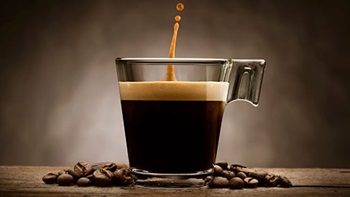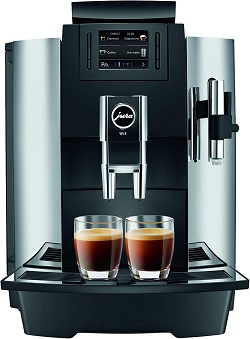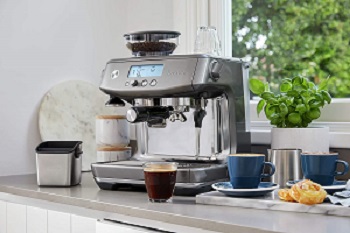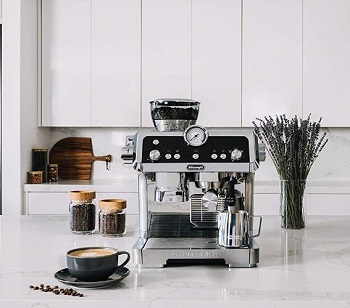If you love espresso drinks, you might be considering whether to buy an espresso machine or a cappuccino machine. What is the difference between the two?
What is Espresso?

Espresso is a coffee drink made using high pressure hot water to extract a concentrated shot of coffee from finely ground coffee beans. This concentrated shot can either be consumed directly (as espresso) or used as the base for various espresso-based drinks, including cappuccinos.
What is Cappuccino?

Cappuccino is typically made by combining equal parts of espresso, steamed milk, and milk foam.
You might also like to read: Our blog on popular espresso-based drinks.
Espresso machines vs Cappuccino Machines
Espresso machines and cappuccino machines are both types of coffee makers, but they serve different purposes and offer different functionalities:
An espresso machine is designed specifically to brew espresso, a strong and concentrated coffee beverage.
It typically uses high pressure to force hot water through finely-ground coffee beans, resulting in a small shot of intense coffee.
Espresso machines often have features like steam wands or frothers to steam milk, which allows users to make various espresso-based drinks such as lattes, macchiatos, and cappuccinos. These machines may come in various types, including manual, semi-automatic, automatic, and super-automatic, offering different levels of control and convenience in the brewing process.
A cappuccino machine is a type of espresso machine that is specifically optimized for making cappuccinos. While it still brews espresso like a traditional espresso machine, a cappuccino machine usually has additional features tailored for creating frothy milk foam, which is a key component of a cappuccino.
Cappuccino machines often include built-in milk frothers or steam wands that make it easy to froth milk to the desired consistency for cappuccinos.
Some cappuccino machines may have preset or programmable settings for producing specific milk foam textures, making them convenient for users who prefer consistency in their cappuccinos.
Type of Espresso Machines
There are several types of espresso machines available in the market, catering to different preferences, budgets, and skill levels. Here are the main types of espresso machines:
- Manual Espresso Machines: Also known as lever espresso machines, these require manual operation to create pressure and extract the espresso. They offer complete control over the brewing process but require a certain level of skill and experience to operate effectively.
- Semi-Automatic Espresso Machines: These machines automate the water flow, but the user needs to start and stop the extraction process manually. Users can control the shot length, making it easier to brew espresso consistently.
- Automatic Espresso Machines: Automatic machines control both the water flow and the extraction time, making the brewing process more convenient. Users can program the machine to dispense a specific amount of water for each shot, ensuring consistency in the espresso.
- Super-Automatic Espresso Machines: Super-automatic machines handle the entire espresso-making process, from grinding the coffee beans to frothing milk and dispensing the espresso. These machines are highly convenient and user-friendly, making them suitable for those who want an effortless brewing experience.
- Pod or Capsule Espresso Machines: These machines use pre-packaged coffee pods or capsules, eliminating the need for grinding and measuring coffee. They are incredibly convenient and easy to use, making them popular choices for home users who want a hassle-free espresso experience.
- Commercial Espresso Machines: Designed for high-volume environments like cafes and restaurants, these machines are robust, durable, and capable of producing numerous shots of espresso quickly. They often come in semi-automatic or automatic configurations.
- Single Boiler vs. Double Boiler vs. Heat Exchanger Machines: Espresso machines can have single boilers, double boilers, or heat exchangers. Single boiler machines use one boiler for both brewing espresso and steaming milk, which can be a bit slower when switching between tasks. Double boiler machines have separate boilers for brewing and steaming, allowing simultaneous operation. Heat exchanger machines use a single boiler with a heat exchanger to maintain different temperature levels for brewing and steaming.
You might also like to read: Our review on the best super-automatic espresso machines.
Type of Cappuccino Machines

Cappuccino machines, also known as espresso machines with milk frothers, come in various types to cater to different preferences and needs. Here are the main types of cappuccino machines:
- Steam Wand Espresso Machines: These machines have a built-in steam wand that allows users to froth milk manually. Steam wand machines are found in many entry-level and home espresso machines. They require some skill and practice to froth milk properly.
- Automatic Espresso Machines with Milk Frother: These machines have an automatic milk frother or steam wand that froths and steams milk with the press of a button. Users can adjust the milk froth density and temperature settings based on their preferences. These machines are suitable for those who want the convenience of automatic milk frothing.
- Semi-Automatic Espresso Machines with Steam Wand: Similar to steam wand espresso machines, these are semi-automatic machines where the user has control over the espresso shot extraction. The steam wand allows manual frothing of milk for cappuccinos. Users can customize the froth and temperature to create the desired milk texture.
- Pod or Capsule Cappuccino Machines: These machines use pre-packaged coffee pods or capsules and often come with a built-in milk frother. They are convenient and user-friendly, making it easy to prepare cappuccinos without the hassle of grinding coffee or manually frothing milk.
- Super-Automatic Espresso Machines with Integrated Milk Frother: Super-automatic cappuccino machines automate the entire process, including grinding coffee, brewing espresso, and frothing milk. They come with integrated milk frothers that can create creamy milk foam for cappuccinos and other milk-based drinks. Users can customize settings such as milk froth density, temperature, and coffee strength.
- Commercial Cappuccino Machines: These machines are designed for high-volume settings such as cafes and restaurants. They often come with multiple steam wands and large boilers to handle continuous milk frothing for a high number of cappuccino orders.
In summary, while both espresso machines and cappuccino machines can brew espresso, a cappuccino machine is specifically designed to facilitate the preparation of cappuccinos by including features for frothing milk, whereas an espresso machine may offer more versatility for brewing various espresso-based beverages beyond just cappuccinos.
You might also like to read: Our recent review on the best cappuccino machines.
Pros and Cons – Espresso Machines vs Cappuccino Machines
When choosing an espresso machine, consider your budget, desired level of control, and the volume of espresso you plan to make regularly. Each type of machine has its pros and cons, so it’s essential to select one that best fits your needs and preferences.
Pros of Espresso Machines
- Rich and Concentrated Coffee: Espresso machines produce a strong and concentrated shot of coffee with a rich flavor, often topped with a layer of crema.
- Versatility: Espresso machines can be used to make a variety of coffee beverages, including lattes, cappuccinos, Americanos, and more, depending on the machine’s features.
- Customization: Many espresso machines allow users to customize the brewing process, adjusting factors such as grind size, water temperature, and extraction time to achieve the desired flavor profile.
- Convenience: Having an espresso machine at home or in the office provides the convenience of making your favorite coffee beverages without the need to visit a coffee shop.
- Cost Savings: Over time, making espresso-based drinks at home can be more cost-effective than purchasing them from a coffee shop regularly.
Cons of Espresso Machines
- Cost: High-quality espresso machines can be expensive, and more feature-rich models may come with a higher price tag.
- Learning Curve: Achieving the perfect shot of espresso requires some skill and experimentation. Learning to use an espresso machine effectively may take time and practice.
- Maintenance: Espresso machines require regular cleaning and maintenance to ensure optimal performance. Neglecting maintenance can lead to issues with the machine and affect the quality of the coffee.
- Space Requirements: Some espresso machines, especially commercial or advanced home models, can be large and take up a significant amount of counter space.
- Initial Setup: Setting up an espresso machine and dialing in the right settings for your preferences can be a bit involved, especially for beginners.
Pros of Cappuccino machines
- Versatility: Cappuccino machines often come with additional features such as steam wands, allowing users to froth and steam milk. This versatility enables the preparation of various coffee beverages, including lattes, macchiatos, and other milk-based drinks.
- Customization: Many cappuccino machines allow users to customize the strength of the coffee, the amount of frothed milk, and the overall flavor to suit individual taste preferences.
- Convenience: Having a cappuccino machine at home or in the office provides the convenience of making a wide range of coffee beverages without the need to visit a coffee shop.
- Cost Savings: Over time, making cappuccinos and other espresso-based drinks at home with a cappuccino machine can be more cost-effective than purchasing them regularly from a coffee shop.
- Consistency: With practice, cappuccino machines allow for consistent results in terms of the coffee strength, milk texture, and overall beverage quality.
- Social Aspect: Owning a cappuccino machine can be a focal point for socializing, as it allows you to prepare and share specialty coffee drinks with friends and family.
- Quality Control: Cappuccino machines give users control over the entire coffee-making process, from choosing coffee beans to adjusting brewing and frothing parameters, ensuring a high level of quality and freshness.
Cons of Cappuccino machines
- Cost: High-quality cappuccino machines can be expensive, and more feature-rich models may come with a high price tag. This initial investment can be a significant factor for some individuals.
- Learning Curve: Using a cappuccino machine effectively, especially those with advanced features, may have a learning curve. Achieving the perfect froth and mastering various settings may take practice and experimentation.
- Maintenance: Cappuccino machines require regular cleaning and maintenance to ensure optimal performance and hygiene. Neglecting maintenance can lead to issues with the machine and affect the quality of the coffee.
- Space Requirements: Some cappuccino machines, especially larger or commercial models, can take up a considerable amount of counter space. This can be a drawback for those with limited kitchen space.
- Limited Mobility: Cappuccino machines are generally stationary appliances, which may be a drawback for those who prefer a portable or travel-friendly coffee-making option.
- Upkeep Costs: In addition to the initial purchase cost, there may be ongoing costs associated with maintaining and replacing parts of the machine, such as filters, gaskets, or other components.
- Complexity: Some advanced cappuccino machines with multiple features and settings may be too complex for users who prefer a straightforward and simple coffee-making experience.
- Single Functionality: While cappuccino machines excel at making specialty coffee drinks, they are primarily designed for espresso-based beverages. If someone prefers other types of coffee, the machine’s capabilities may be underutilized.
Summary: Should I buy an espresso machine or a cappuccino machine?

Espresso machines or cappuccino machines can produce excellent drinks at the touch of a button. Which should you consider buying? Or, should you buy a machine at all?
Whether you should buy a machine at all is a complex question. How many espressos and/or cappuccinos do you plan on consuming? How much is the added convenience worth to you? See the section on these machines to detail some of the things you may want to consider.
If you are choosing between an espresso machine and a cappuccino machine, remember that cappuccino requires heated and frothed milk. You can make espresso and then use a separate milk frother to make cappuccino, but it is much more convenient to use a cappuccino machine to automate the steps involving milk with a cappuccino machine.
You might also like to read: Our in-depth comparison of the best De’Longhi Espresso Machines.
FAQ’s
Q1: Is Cappuccino just Espresso with milk?
Yes, a cappuccino is made with equal parts of espresso, steamed milk, and milk foam, distinguishing it from plain espresso.
Q2: Difference between Espresso and Americano
Espresso is a concentrated coffee brewed by forcing hot water through finely-ground coffee under high pressure. It is made from a specific blend of coffee beans and does not contain any added ingredients.
An Americano is made by diluting a shot of espresso with hot water. It consists of espresso and hot water, and the ratio of espresso to water can vary based on personal preference.
Q3: Difference between Cappuccino and Latte?
A cappuccino is made with equal parts of espresso, steamed milk, and milk foam. The ratio is typically 1/3 espresso, 1/3 steamed milk, and 1/3 milk foam.
A latte is made with one or two shots of espresso and steamed milk. It has a small amount of milk foam on top, usually a thin layer to preserve the creamy texture.